 |

A selection of Observations of fragmenting comet 73P SW3 fragments B and C from March 28th - May 16th 2006.
At 23.10 BST this evening I made my first observation of 73P/ SW3 fragment C with the 8" LX10 F/6.3 at 49X located to the SW of Arcturus high in the eastern sky under a beautiful dark clear sky. Trans and seeing 8/10.
The comet was small with a dia of 1 - 2' with a bright star like central condensation and well condensed at DC:7? I seen what appeared to be a faint dust tail for +3' long. The comet is very easy to see and if it looks like this now then it could put on a good show in May assuming it doesn't fizzle out before then. I am very pleased to see this comet and will be following it from night to night watching it grow as it becomes a naked eye object. I made a quick sketch at the eyepiece and will re observe it again later in the night.
Had a great observing session last night from 03.00 - 04.00 BST in the pre - dawn hours. The sky was incredible with excellent transparency / seeing with a very dark sky background. Stars to mag 7 were glimpsed with the naked eye and the milky way in Cygnus was like a cloud with striking dark complex dust lanes.
Using the 8" F/6.3 at 49X I hunted down C/2006 A1 Pojmanski which was located very close to a bright naked eye star in Lacerta. The comet was a blue circular fuzz ball, moderately condensed with a bright white soft central condensation. I could make out a faint, straight colorless ion tail for > 3' to the NW. The comet looked nice against a milky way background. Mag 7, D.C: 6, Dia: 3'
Last night I observed from 02.00 - 04.00 BST with the 8" F/6.3 SCT at 49X. The sky was incredible, very black sky background, no lights on in neighbour hood at all, trans 9, seeing 7. The milky way was awesome, glowing like a cloud with complex vivid dark dust lanes extending the entire length of the sky into the east where it split in two bands within Aquila. Seen stars to mag 7.0 with naked eye and the variable star Chi Cygni on its rise to maximum like a Nova at mag 6.3?.
I tracked down C/2006 A1 Pojmanski in Lacerta, mag: 8.5, Dia: 3' DC: 5 blue circular coma that has gotten somewhat more diffuse and soft at it's edges with a bright white soft central condensation. Seen faint colourless ion tail extending + 5' to the NW and a possible dust tail pointing south for 2' with a field star within the tail. Comet is still very easy to see.
Quickly swept up 73P/ SW3 - fragment C to the SE of Arcturus. Mag 9.5 Dia: 1 - 2', DC:7...tiny grey coma, well condensed and easy to see with sharp edges and sporting a brilliant white stellar central condensation. Bright fan shaped dust tail pointing south for 5' and suspected to 8' in length with a bright spine like feature running through the centre of the ghostly tail. Comet is looking good!
Had a great observing session on the morning of the 5th before dawn. Trans = 7 - 8, Seeing = 7, low level murk, light high level cloud, very cold, semi dark sky with near first 1/4 Moon low in west. Using John Mc Connell's 8.5" Dobsonian with 40mm eyepiece I observed the following...
C/2006 A1 Pojmanski 02.00 UT
Circular patch of light that gradually got brighter toward the centre. Coma is evidently fainter and more diffuse with soft edges and an overall subtle blue colour. No central condensation / false nucleus or tail visible. Comet looks nice in a dense milky way star field within Lacerta. Mag 8.7 Dia 2.5' DC: 5
73P/ SW3 - Fragment C 02.15 UT
Tiny very well condensed coma with sharp edges sporting a very bright white stellar false nucleus and a dust tail stretching 4' - 5' SW which broadens with distance away from the sun in a slight elongated fan shape with bright spine like feature at its centre. Tail was grey however with concentrated averted vision it looked slightly blue? Comet is looking very nice! Mag 9.5 Dia 1' DC:9?
73P/ SW3 - Fragment B 02.30 UT
Located several degrees North of fragment C. Compact circular grey coma, well condensed with sharp edges and a brilliant stellar false nucleus. No tail seen. B is strikingly brighter and larger than main component C. Mag 9 (or slightly brighter?) Dia 2' DC: 8
Great to see three different comets in the one session!
Had a beautiful sky at 03.00 UT this morning. Seen twin Moon pillars followed by a single pillar 10* high and several Lyrid and Virginid meteors.
With the 8" Dob with 40mm eyepiece yielding a FOV of over 1* I observed Nova Cygni 2006, C/2006 A1 Pojmanski (faint + Diffuse), 73P/ Schwassmann - Wachmann 3 fragments C and B. Both were bright and each had a dust tail pointing SW that was very obvious despite strong Moonlight. Rounded the session up with a short moonlight comet hunting session and a look at M27, M71, M56, M13, M92, M57, Double cluster, Moon and Jupiter. Great session..1 Nova and 3 comets and to top it all of it started snowing heavily on me!!
I had yet another great session last night even though I am currently dying with the cold. I set up the 16" and 8.5" dobsonians side by side until the clouds broke and revealed a pretty good clear sky that stayed that way for the remainder of the night. With the 8.5 " I searched for comets in the late evening twilight and picked up M35. CrB had now climbed high into the eastern sky well placed out of any horizon murk so I turned my attention to the 'string of pearls' comet that is rapidly moving east ward as it approach's both the Earth and the sun.
01.10 BST
I swept up fragment C very quickly located between RCrB and Hercules. This is a beautiful comet! The coma is tiny, compact, well condensed and of a parabolic shape on the sun ward side. In the middle was a bright stellar central condensation with a slender spine 3' long running into the tail. The dust tail itself is broad and I detected it for 25' - 30' long pointing to the SW. The first 15' of tail is easy to see but the remainder needed averted vision for its full detection. I also glimpsed several streamers. This comet is looking very healthy. Mag: 7.5 Dia: 2' D.C: 7
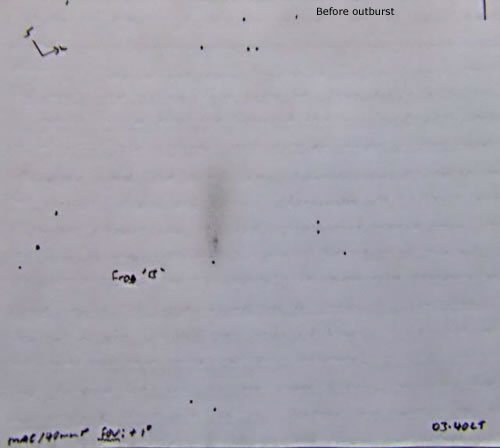 |
00.56 BST
WOW!!!! I couldn't believe my eyes when I swept up fragment B. Three Nights ago it was a faint diffuse object with barely any CC within the coma however tonight a transformation had taken place. This comet is suffering from a bright outburst!! The central condensation is a brilliant white stellar object with diameter! The coma is fairly large and moderately condensed with a bright dust tail 15' long pointing SW. This is a very exciting fragment. I spent alot of time observing and sketching both comets.
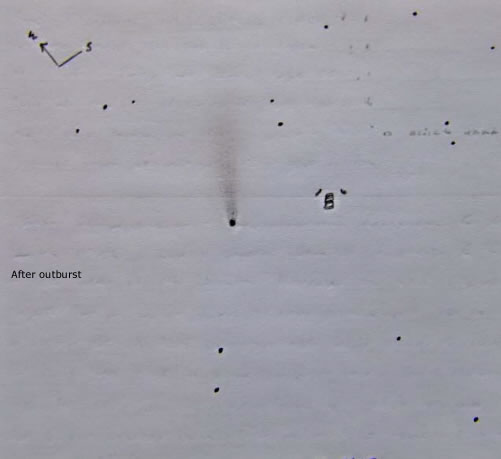 |
73P/ SW3 fragments C and B were lovely telescopic objects last night. I could see them both very easily in my 10X50 binos. C was elongated however B looked easier with more of an oval shape with a bright CC observed. At 00.50 UT when Hercules was nearly at the Zenith I could clearly see fragment C with the naked eye as a fuzzy patch of light!! At first I seen it with averted vision then several times with direct vision...the comet was unmistakable. Perhaps the recent visual magnitude estimates of C have been on the conservative side and underestimated?
I got some comet hunting done last night then the clouds really thickened up however they were moving fast with regular small clear gaps so I spent 2 hours observing 73P SW3 - C with the 10X50 binos. I can confirm that the coma is much larger and brighter in binos compared with a telescope, larger instruments are generating false coma diameters, DC ratings and magnitudes and as such most of the recent estimates have been on the conservative side plus the visual observers are seeing more coma than the CCD imagers
Had a great look at these two comet fragments last night. In the 8.5" fragment C was a proper comet with stellar central condensation well condensed coma (it has grown larger) and a long dust tail 30' long pointing SW with faint slender spine and numerous ion streamers radiating away from the coma. Fragment B also sported a bright stellar CC (in outburst again) with very short stubby 10' long dust tail pointing SW.
Both comets were large bright objects in the 10X50 binos with C showing a long slender tail and B sharing the same FOV as M13. I got to experience 'aperture affect' first hand tonight, using my 8X22mm binos both comets were remarkably larger and brighter compared with the view in the 10X50's.
Fragment C was a very easy naked eye object tonight that looked like a large grey fuzzy patch with the coma and tail combination extending at least 15' in dia although I suspect it is much larger! This comet must easily be mag 6.0 (in my opinion) and much brighter than what others are estimating.
I also spotted fragment B with the naked using averted vision as a small soft stellar source that was quite easy to see and I reckon it was mag 6.5 - 6.7 with ease and again brighter than predicted by others! In fact with the naked eye I could see fragment C, M13 and B all at the same time.
Trans = 8/10 seeing = 10/10 background sky slightly grey due to illumination of of waxing crescent moon low in NW. Spent 1.5 hours comet hunting before dawn with the 16" and picked up a nice selection of star clusters.
Ended session at 04.00 BST
Both these comets looked great last night. I observed them from a country location from 00.35 - 02.35 UT. Trans = 7 - 8, semi dark sky with waxing crescent moon low in west dimmed by low level murk.
I could see both comets easily in my 8X22mm binos with component B very close to M13, C had a fairly easy long dust tail. Fragment C, M13 and B where all easy naked eye objects. B seemed easier to see than C tonight without any optical aid. These comets are brightening fast!!
Here's a quick sketch I done last night of both comets (C and B) as they looked with the naked eye within Hercules at 01.30 UT. M13 can be seen between the two fragments.
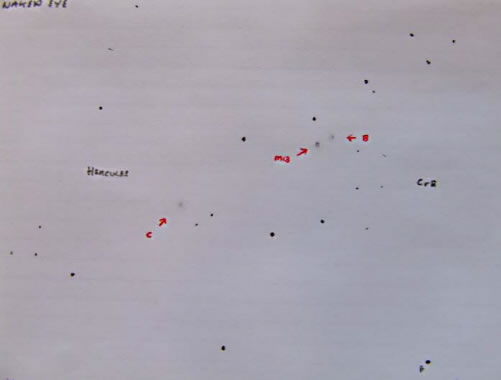 |
Here's a few quick sketches I made last night when I observed both comets with my 10X50 binos, observation made between 03.30 - 04.00 BST when Hercules was near the zenith in morning twilight.
The first sketch is of B with 44 Herculi and M13 in the same field.
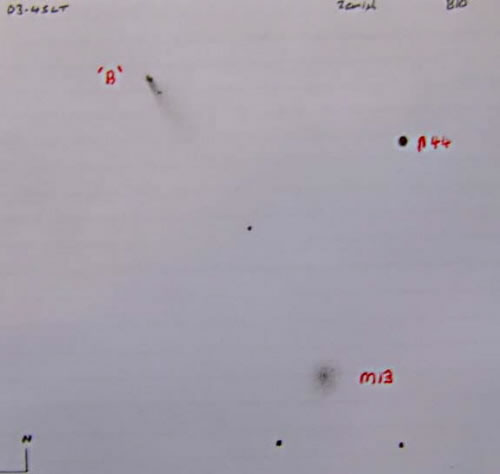 |
Second sketch is of C with a + 1 degree long tail.
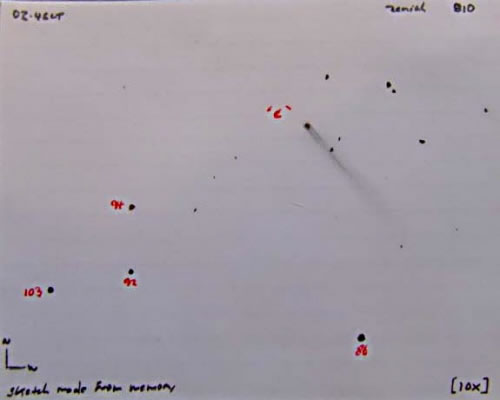 |
The last portrays both comets as seen with the naked eye including M13. I seen C's tail without optical aid and it looked like a white needle!
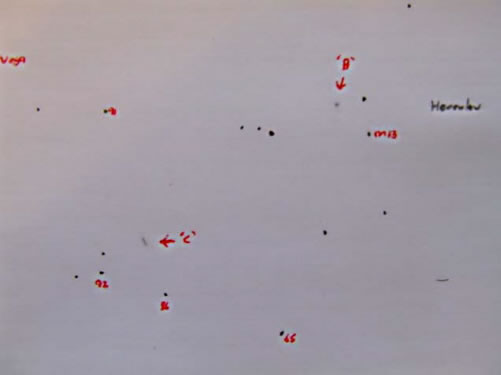 |
Conor and I both spent considerable time observing comets 73P SW3 fragments C and B both placed high in the sky within Hercules racing at a fast pace towards the western fringes of the 'summer triangle'. C was a bright object in our 10X50 binos with an aqua - green moderately condensed coma and a slender dust tail extending for two full moon diameters running parallel with the horizon. B shared the same binocular field as globular cluster M92 , this comet was also a green colour but I did find the coma to be larger, fainter and more diffuse tonight. I could not make a positive ID with the naked eye however I could easily see fragment C as a bright slim streak without much difficulty, seen a bright 'bino' meteor shoot through the FOV narrowly missing the comet. We took a number of images of the fragments, in my case I could just about pick up C as a green ball using a 15 sec exp at ISO 800.
The comets were 'first light' for my new Bresser 10X50 binos which I had just bought this evening before sunset.
Here's a few images I took last night before dawn from the country using my Fuji S5600 5MP camera at ISO 800 - 1600 / 15 sec exposure and high optical zoom. Images are unguided. My camera has no noise reduction so the images are very noisy / grainy however I did pick up the green coma of C within Lyra below Kappa Lyrae. At the time the moon was low in the west obscured by clouds, the east was bright with approaching dawn but at the zenith the sky was beautiful and Dark. In the 10X50s C was in the same FOV as Vega and I could also see it with the naked eye. B was faint and diffuse.
Sky is terrible here with dense murk illuminated by bright moonlight with only the bright naked eye stars visible. No detection with 10X50 binos but with the 8.5" I swept up B to the east of Vega. Could only see the brighter inner coma and central condensation (possible gas streamers seen) with a hint of tail to the SW, will try again later when it rise's higher. Jupiter and the moon look awesome though due to very good seeing conditions. The moon looks slightly reddened even though it is a respectable distance above the horizon...wish this murk would lift.
Last night I got a better look at the comet from 02.00 - 03.30 BST when Lyra was high in the sky to the east of the Meridian. Fragment B was a beautiful sight in the 10X50s as a greenish bright misty patch close to the binary star Epsilon Lyrae sporting a wedge shaped coma in the anti - solar direction with soft stellar central condensation and a slender dust tail pointing to the SW, the coma looked to have good structure. The sky was terrible with dense murk illuminated by strong moonlight trans = 2 - 3 seeing = 9 however despite these horrible conditions I was delighted and shocked to see fragment B with the naked eye as a hazy patch first with averted vision then direct vision..what a beautiful sight!!! I spent along time just standing there watching it!!!! Mag: 5.0 Dia: 15' (half a moon diameter) DC:6.
Here's a quick sketch through the binos.
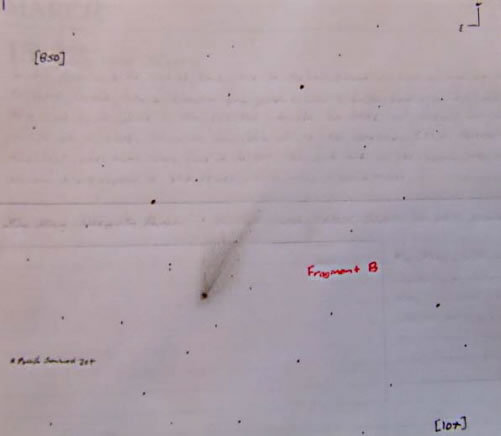 |
I got my best look yet at fragment B on wednesday night (10th) from 23.00 - 03.30 BST. In John Mc Connell's 8.5" F/7 dobsonian with 40mm eyepiece the comet was a beautiful object sporting an 'arrow' or 'spear' shaped coma with a tiny star like false nucleus, running from this was a bright slender spine that merged with the dust tail, the coma consisted of a fainter fan shaped dusty material at a broad angle to the FN embedded with numerous delicate gas streamers. What absolutely astonished me was the rapid speed of the comet against the background stars which is evident on my quick sketch made at two different times.
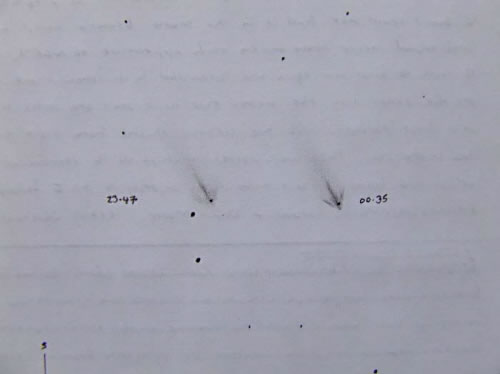 |
I could actually see the comet drifting across the telescopic field in 'near' real time which was both incredible and frightening! In the 10X50s the comet was a large bright object in the same field as 20 and 21 Lyrae with a slender dust tail. I was amazed to see the comet with the naked eye as a 5th mag patch of light to the east of Vega with a dia of 15', DC:6 this was a surprise as the sky was in very poor shape, Trans = 3 - 4 seeing = 9 with dense murk illuminated by bright moonlight. Comet is putting on a nice show!
 |
The sky cleared up beautifully from Maghera last night just after the EAAS meeting and despite the bright lingering twilight the sky overhead was dark with a glorious milky way, the transparency was excellent with a very clean sky thanks to the showers earlier in the day. While talking on the phone to John Mc Connell I observed 73P SW3 fragments B and C with the 10X50 binos. B was a stunning bright comet in Pegasus at 5th mag (or brighter?) sporting a brilliant moderately condensed coma (DC:6) that was shaped like an elongated diamond in the anti solar direction which merged with a slender dust tail 1 degree long. The central condensation was a stellar object with a coma that has increased in size since my last observation several days ago, I noticed even in the binos that there was material extending from the coma in a sun ward direction that looked a little like an anti - tail however CCD images have shown this feature to be a bright jet. The comet was an easy naked eye object hanging over my neighbors rooftop beside an aerial..comet looks great! had a closer look at both comets with the 8.5" reflector and stopped for a nosy at M15 then retired for the night at 03.00 BST.
 |
I was observing fragment B at 02.00 with the 10X50's in an excellent sky and was amazed how its visual profile has changed since last night were it had an elongated diamond shaped coma however last night it looked like a classic comet with a long broad fan shaped dust tail extending over 1 degree, coma and tail merged together as one unit with a parabolic shape on the sun ward side, moderately condensed (DC:6) with stellar CC. I only got short lived periodic glimpses because of passing clouds. C is in the south of Pegasus but I could not see it due to clouds...B is a great looking object!
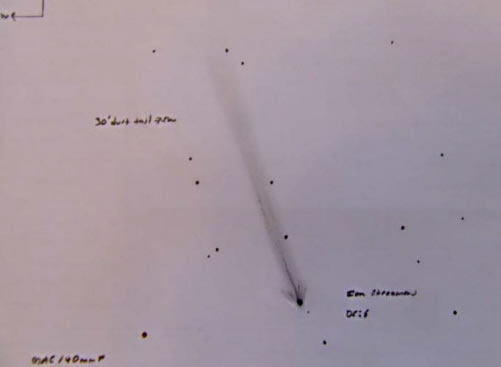 |
At 00.30 BST I was aligning the telrad on the 16" for a comet hunting session when suddenly a fireball lit up the broken clouds above me moving from east to west within Uma..as for a mag estimate I am not certain but perhaps brighter than Venus. There was an aurora seen last night from the Uk However I didn't see anything from here.
Martin Mc Kenna
Also see...